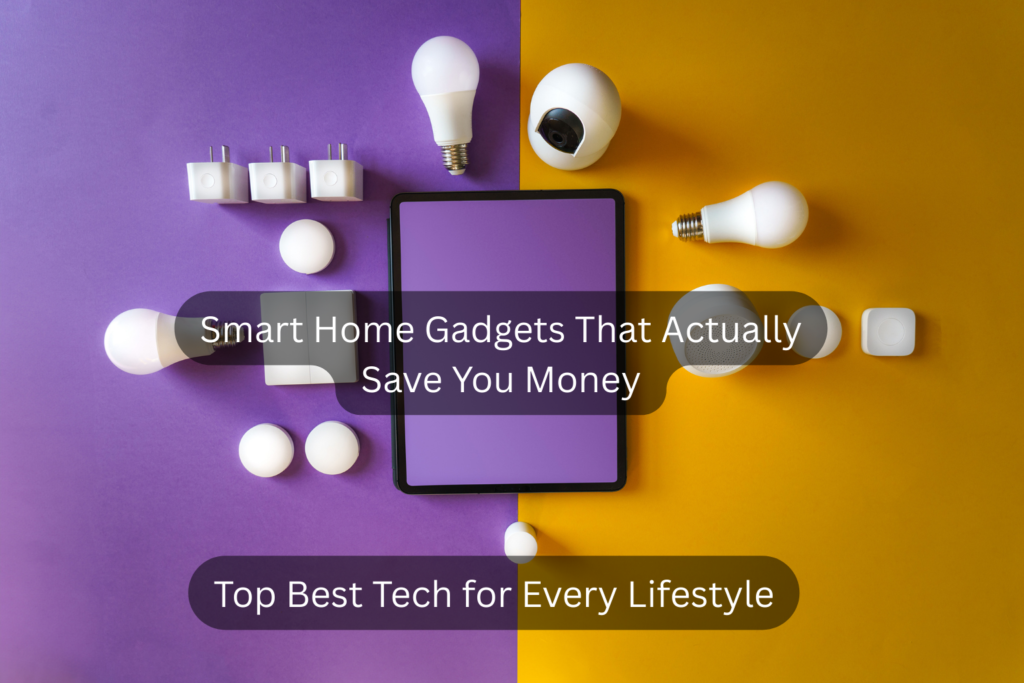Why Smart Home Gadgets Are Worth It
Smart home technology isn’t just about convenience—it’s about saving money. With heating and cooling costs making up nearly 50% of the average household energy bill (U.S. Department of Energy), plus hidden losses from water leaks and standby power, smart gadgets are a proven way to cut expenses.
In this guide, we’ll explore the top smart home devices in 2025 that reduce costs, real-world savings data, and tips to maximize efficiency.
Why Invest in Smart Home Gadgets for Savings?
- Energy Efficiency: Cut heating/cooling costs by 10–26% with smart thermostats.
- Water Conservation: Prevent thousands of gallons of waste with leak detectors.
- Reduced Standby Power: Eliminate “vampire energy” draining 23% of your bill.
- Financial Incentives: Many devices qualify for utility rebates.
Top Smart Home Gadgets That Save You Money
1. Smart Thermostats – Lower Heating & Cooling Costs
Popular options: Nest Learning Thermostat, Ecobee SmartThermostat Premium
- Savings: 10–26% annually on HVAC bills ($100–$145 avg. household).
- Cost: $80–$250 (rebates available).
- Payback: 1–2 years.
💡 Pro Tip: Use geofencing to auto-adjust when you’re away.
2. Smart Lighting – Energy-Efficient Brightness
Top picks: AiDot Linkind, Philips Hue, TP-Link Kasa Smart Plug Slim
- Savings: 7–27% on lighting costs (5–10% of total bill).
- Cost: $10–$50 per bulb, plugs from $9.
- Benefits: Longer bulb life, scheduling, remote control.
💡 Pro Tip: Pair with motion sensors for maximum efficiency.
3. Smart Plugs & Power Strips – Stop “Vampire Power”
Devices: Amazon Smart Plug, Emporia Smart Plug
- Standby power = 23% of energy bill.
- Cost: $9–$30.
- Features: Scheduling, remote off, usage tracking.
💡 Pro Tip: Use for consoles, chargers, and kitchen appliances.
4. Smart Leak Detectors – Prevent Water Damage
Options: YoLink, Moen Flo Smart Leak Detector
- Wasted water: 10,000 gallons per year (avg. home).
- Cost: $40–$60 (basic), ~$400 for auto shut-off systems.
- ROI: Saves thousands in repair costs.
💡 Pro Tip: Place near washing machines & water heaters.
5. Smart Sprinkler Systems – Cut Outdoor Water Use
Examples: Rachio, Eve Aqua
- Savings: Up to 10% on water bills.
- Cost: $100–$300.
- Features: Weather-based schedules, plant-specific watering.
💡 Pro Tip: Many water utilities offer rebates.
6. Smart Energy Monitors – Spot Hidden Energy Drains
Devices: Sense, Emporia Energy Monitor
- Savings: 20–30% by reducing inefficiencies.
- Cost: $200–$300.
- Use Case: Identify inefficient appliances, plan upgrades.
💡 Pro Tip: Replace old power-hungry appliances.
How to Maximize Savings with Smart Gadgets
- ✅ Integrate with Hubs (Amazon Echo, Google Nest).
- ✅ Claim Rebates from utilities.
- ✅ Use Sensors/Geofencing for automation.
- ✅ Schedule Off-Peak Use for appliances.
- ✅ Start Small with plugs & bulbs before upgrading.
Pros & Cons of Smart Home Gadgets
Pros
- Significant utility bill savings.
- Increased home convenience & automation.
- Rebates make devices more affordable.
- Helps eco-conscious households reduce footprint.
Cons
- Upfront cost (some devices $200+).
- Compatibility issues with older setups.
- Some require professional installation.
- Ongoing app updates & maintenance needed.
FAQs – Smart Home Gadgets That Save You Money
Q1. Do smart home gadgets really save money?
Yes—smart thermostats, lighting, and plugs can save 10–30% annually on utilities.
Q2. Are these devices expensive to install?
Most are plug-and-play. Thermostats or leak shut-off valves may require pros.
Q3. How fast do smart home devices pay for themselves?
Typically within 1–2 years, depending on energy usage and rebates.
Q4. Can renters use smart gadgets?
Yes—smart plugs, bulbs, and leak detectors are renter-friendly and portable.
Q5. Which device offers the biggest savings?
Smart thermostats usually deliver the highest ROI.
Q6. Are smart devices secure?
Yes, but you should update firmware regularly to prevent risks.
Q7. Do utilities offer rebates for these gadgets?
Many do, especially for thermostats and sprinkler systems.
Conclusion: Smarter Homes, Lower Bills
Smart thermostats, lighting, leak detectors, and other devices are not just “cool tech”—they’re money-saving investments. With upfront costs often paid back in 1–2 years, plus available rebates, these gadgets deliver long-term savings, efficiency, and peace of mind.


